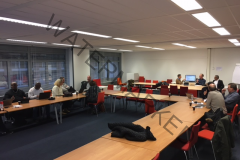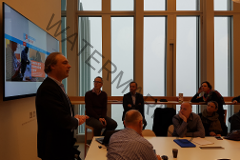Pagina Inhoud
![]()
Producing (modular) products is still a rarity in the world of main contractors but it might be the only way to close the knowledge loop! Suspended ceilings and up to ten built-in components are designed by many different parties, produced separately and mounted on the construction site by up to six different participants. This current practice is causing loss of time, money and quality in the construction industry. Could a change in the Client Order Decoupling Point be the answer, to enable a modular product and process as is common in the car industry and many other industries?
For architects to accept a modular product which stays visible and is a major part of an office space, the product must score high on aesthetics. Multiple architects and technical stakeholders were interviewed to determine their wishes. Reverse engineering is applied and through a cycle of modular function deployment a modular suspended ceiling product is proven to be viable, reducing cost of labour, failure and re-design. Resulting in new and efficient design and build processes (June 1st 2018)
![]()
Author: Martin de Bree University of Applied Sciences HU
1st Thesis Supervisor: T. Beckers University of Applied Sciences HU
Unlike the production industry, the concept of the client order decoupling point is not very well known or used within the world of construction. The CODP is defined by Rudberg & Wikner [1] as the point in the value-adding material flow that separates decisions made under uncertainty, from decisions made under certainty, concerning customer demand. More simplified: How much of your product is designed and made based on client specifications? This could vary from completely to nothing at all.
Rudberg & Wikner [1] describe how customers want products that fit their specific needs, but customers are not willing to pay high premiums for these customized products compared to competing standard products. You could state that people want products to be unique but for the prize of a standard product.
According to ING [2] the building industry is often presented with designs made by architects and advisors and compares this with people ordering custom cars instead of configuring a car based on a fixed model solution. McKinsey Institute [3] states in her report that customers will be prepared to accept more standardized products when they are offered sufficient freedom in choice to meet their requirements and against lower prices. However, the construction industry seems more or less forced to stay in the corner of pure customization although this comes with high risk, low prices and small margins. [3] Builders have become main contractors and they don’t produce many of their own products. The research of Dubois & Gadde [4] showed that approximately only 25 per cent of a construction project is built by own personnel and production facilities. The other products are delivered and built by third parties that are under subcontract. The final assembled or produced product (A building) is a largely customized end product consisting of components that are not necessarily designed or produced to be assembled together, the processes are custom oriented as well for this reason. The battle of the CODP is nicely displayed in Figure 0‑1.
Click to enlarge
Figure 0‑1 The Productivity-Flexibility Trade-off and the Positioning of the CODP [1]
Methodology
The research started by determining the dream state of the suspended ceiling for the architects. This was done by interviewing seven renowned architects decoding the results and these results were then validated through a questionnaire. From the main contractor perspective, the optimal design and build process and the properties and effects of the current processes were uncovered, during five separate focus group interview sessions with technical and process stakeholders [5]. Next, the findings were compared and analysed to determine the optimal CODP [6] [7].
Main findings
There are many findings, but there are three main findings. The first main finding is that both the main contractor and architects are willing to reposition the CODP from a level 5-7 to a level 3-4. This means the design process starts with configuring an order, based on modular components like most people are used to doing when ordering a new car. The current CODP level 7, starts with an architect designing a suspended ceiling and technical advisors positioning the technical components in it. The main contractor then has to do a lot of detailed engineering to position all of the components in a place where it can work correctly but this is often not based on aesthetics. The architect will use his influence to reposition components but lacks knowledge on functionality of the components. After a few cycles the suspended ceiling becomes a compromise between technique and aesthetics.
The willingness to change this process to configure to order from both sides gives the opportunity to design a modular based ceiling where each component has a fixed position where it functions without any compromise.
Click to enlarge
Figure 0‑2 Optimal CODP Design and Build Process Adapted from Rob Dekkers [7] and Lampel & Mintzberg [8]
For an architect to accept less influence in the design of a suspended ceiling he / she must be happy with the aesthetic end result from the start. The final product must therefore live up to their expectations. The second main finding is that the architects that were interviewed seem to have a similar set of rules to determine if a suspended ceiling is well designed. The wanted end result is best described as a clean look. There are five major aspects that need to be optimized to ensure that. Each of these major aspects have sub aspects that need to be controlled. These aspects are gathered through coding the interviews and by asking the architects to rank each of them on a scale of 1-5 how important they find it and on the same scale of how satisfied they are with these aspects in their own finished and delivered projects. The ‘building blocks’ for a clean look are shown in a cause and effect diagram in Figure 0‑3.
Click to enlarge
Figure 0‑3 Ishikawa Diagram of the Current State Product [6]
The third main finding is a change in the design and build process that enables the use of modular products with a minimal need for engineering and maximum re-use of knowledge by closing the knowledge loop within the individual processes and between the two separate processes as well. These processes are shown in Figure 0‑4. Important new steps are:
- The configuration process;
- Use of a Modules database which is kept up to date;
- Change management, changing the child within a project or the mother across multiple (future) projects;
- Multiple test moments and feedback loop to the modules database;
- Feedback loop from user experience providing base for lifecycle evolution.
Click to enlarge
Figure 0‑4 Future Design and Build Proces
![]()
Conclusion
The architect wants a clean looking final product. This means he aims for a product that has a logical placement of components, lines which are minimized and logically connected, a flush ceiling without anything sticking out underneath, equal colouring of the ceiling and components and a ceiling which stay clean even after disrupting parts of the ceiling. The level of freedom he is looking for is always with the aim to come closer to this goal. When this goal is reached by the product, his influence will be minimized, enabling CODP-3 or 4. The optimal CODP is level 3, because this enables a configure to order process, instead of design to order. This changes the supply chain, resulting in far less design cost and less variants, but still providing sufficient choices for the architect to fulfil his needs. It also enables a far more efficient new design and build process with feedback loop that enables learning within and across projects. The result is the introduction of a modular designed suspended ceiling, which holds all normally used components in a fixed position and complies completely with the aesthetical demands of the architects.
References
1 M. Rudberg and J. Wikner, “Mass Customization in terms of the Customer Order Decoupling Point,” Production Planning & Control: The Management of Operations, Sweden, 2004.
2 E. B. ING, “Technologie in de Bouw,” ING, Economisch Bureau, 2016.
3 McKinsey Institue, “Reinventing Construction: A Route to Higher Productivity,” McKinsey Global Institute, 2017.
4 A. Dubois and L. Gadde, “Supply Strategy and Network Effects – Purchasing Behaviour in the Construction Industry,” Chalmers University of Technology, Dep. of Industrial Marketing, Gothenburg, 2000.
5 R. Merton, M. Fiske and P. Kendall, “The Focused Interview,” Bureau of Apllied Social Research, Columbia University, New York, 1956.
6 L. Callaert, Inleiding in Productiemanagement, Heerlen: Open Universiteit Heerlen, 1995.
7 Rob Dekkers, “Engineering management and the Order Entry Point,” International Journal of Produktion Research, pp. 44:18-19, 4011-4025, 2006.
8 J. Lampel and H. Mintzberg, “Customizing Customization,” Sloan Management Review / Fall 1996, pp. 21-30, 1996.
9 T. Zaal, Integrated Design and Engineering, MAJ Engineering Publishing, 2009.
10 A. Ericsson and G. Erixon, Controlling Design Variants: Modular Product Platforms, New York: ASME, 1999
11 K. N. Otto and K. L. Wood, “A Reverse Engineering and Redesign Methodology for Product Evolution,” ASME, Irvine, California, 1996.
Discuss or give your opinionFollow on FacebookFollow on Twitter
Verwante Artikelen
Tags: Article, Assetmanagment, Risk









